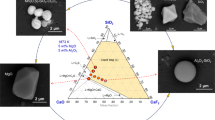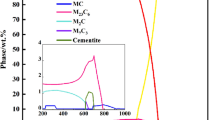We study the regularities of oxide formation on steel of the SUH409L ferritic class (Fe–11Cr) in the case of diffusive oxidation (at temperatures of 600–800°C, for 24–150 h in an argon-oxygen mixture with about 20% of oxygen) and its influence on the long-term strength of steel in lead melts at 600°C. It is shown that, as the temperature and duration of oxidation increase, the phase composition of the film evolves, as a result of the intensification of the diffusion of chromium in surface layers, from magnetite to chromium-containing spinel (Fe, Cr)3O4 with formation of the islands of Cr2O3 chromium oxide. The grain size increases from 35–40 mm to 60–80 mm. It is shown that the process of oxidation weakens the negative effect of the lead melt and, hence, the long-term strength of the oxidized steel on a base of 100 h increases by 15%.





Similar content being viewed by others
References
Comparative Assessment of Thermophysical and Thermohydraulic Characteristics of Lead, Lead-Bismuth, and Sodium Coolants for Fast Reactors, IAEA, Vienna (2002), IAEA-TECDOC-1289.
P. E. MacDonald and J. Buongiorno, “Design of an actinide burning, lead or lead-bismuth cooled reactor that produces low cost electricity,” in: INEEL/EXT-01-01376. MIT-ANP-PR-083. FY-01 Annual Report, Idaho National Laboratory (2001), pp. 181–223.
J. U. Knebel, X. Cheng, G. Muller, G. Schumacher, J. Konys, and H. Glasbrenner, “Thermal-hydraulic and corrosion challenges for the target module of an accelerator-driven system (ADS),” in: Proc. of the 3rd Internat. Topical Meeting on Nuclear Application of Accelerator Technology, AccApp’99, Long Beach, CA, American Nuclear Society, La Grange Park, IL (1999), pp. 367–376.
B. van der Schaaf, D. S. Gelles, S. Jitsukawa, A. Kimura, R. L. Klueh, A. Moslang, and G. R. Odette, “Progress and critical issues of reduced activation ferritic-martensitic steel development,” J. Nucl. Mater., 283–287, 52–59 (2000).
K. Ehrlich, E. E. Bloom, and T. Kondo, “International strategy for fusion materials development,” J. Nucl. Mat., 283–287, 79–88 (2000).
A. Weisenburger, A. Heinzel, G. Müller, H. Muscher, and A. Rousanov, “T91 cladding tubes with and without modified FeCrAlY coatings exposed in LBE at different flow, stress and temperature conditions,” J. Nucl. Mat., 376, 274–281 (2008).
O. I. Yas’kiv, V. M. Fedirko, and I. S. Kukhar, Influence of oxygen-containing lead melts on the fatigue strength of AISI 409L steel at elevated temperatures,” Fiz.-Khim. Mekh. Mater., 50, No. 5, 34–38 (2014); English translation : Mater. Sci., 50, No. 5, 659–664 (2015).
W. Kraus and G. Nolze, “Powder cell—a program for the representation and manipulation of crystal structures and calculation of the resulting X-ray powder patterns,” J. Appl. Cryst., No. 29, 301–303 (1996).
Author information
Authors and Affiliations
Corresponding author
Additional information
Translated from Fizyko-Khimichna Mekhanika Materialiv, Vol. 52, No. 3, pp. 69–73, May–June, 2016.
Rights and permissions
About this article
Cite this article
Yas’kiv, O.I., Fedirko, V.M., Kukhar, I.S. et al. Influence of Diffusive Oxidation on the Long-Term Strength of Ferritic Steels in Lead Melts. Mater Sci 52, 371–376 (2016). https://doi.org/10.1007/s11003-016-9966-5
Received:
Published:
Issue Date:
DOI: https://doi.org/10.1007/s11003-016-9966-5




